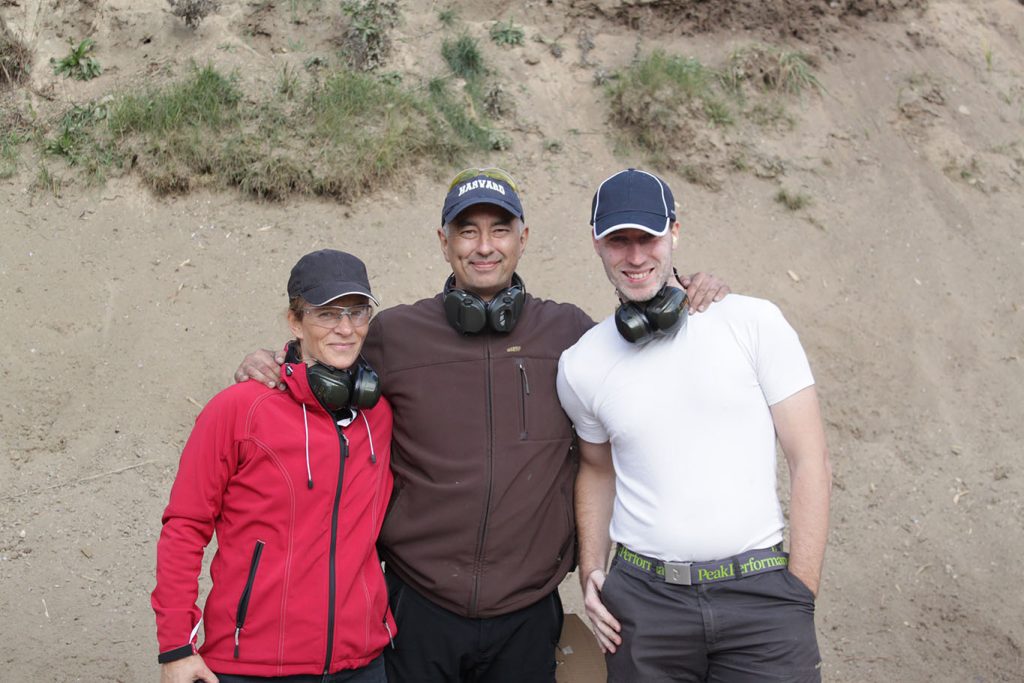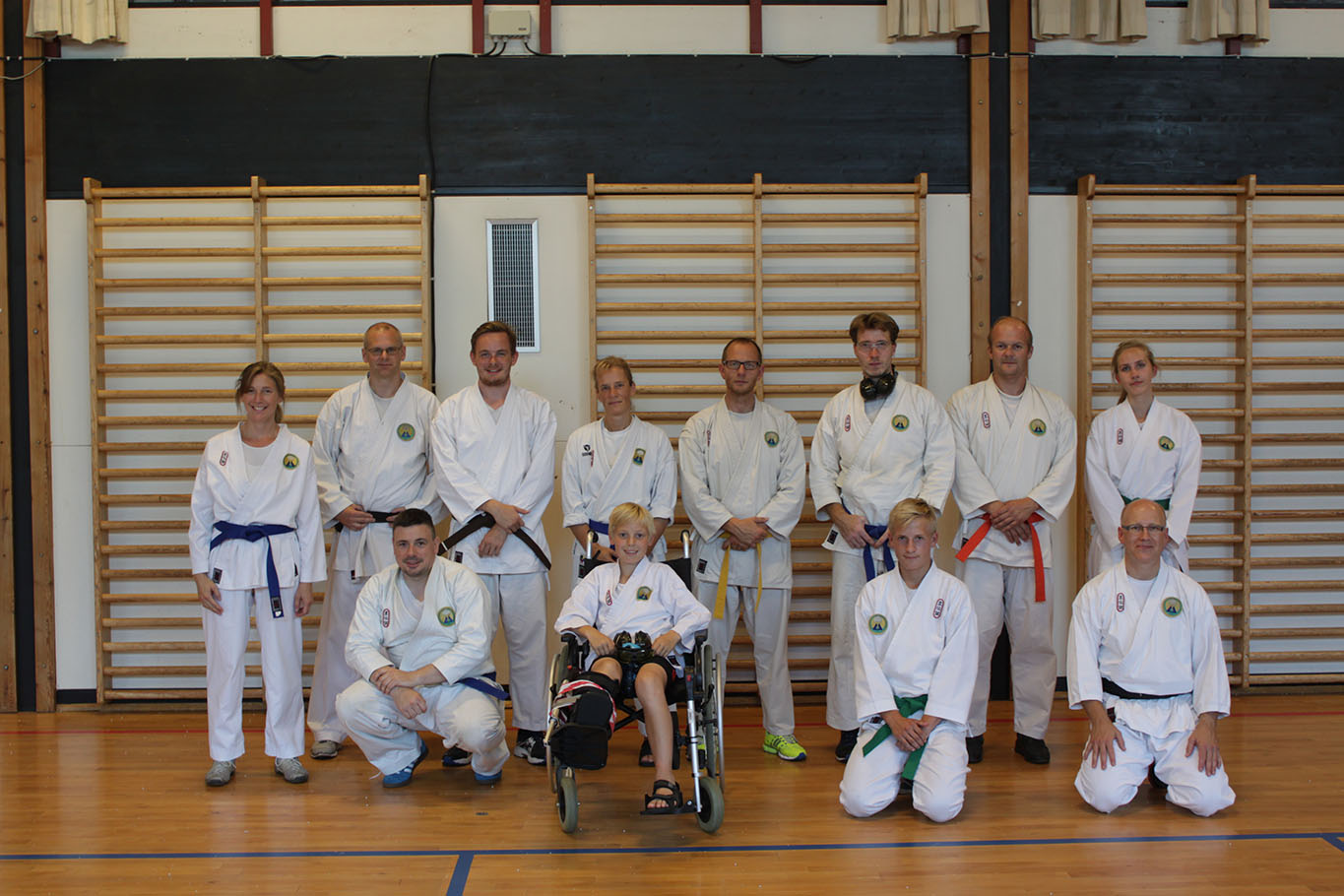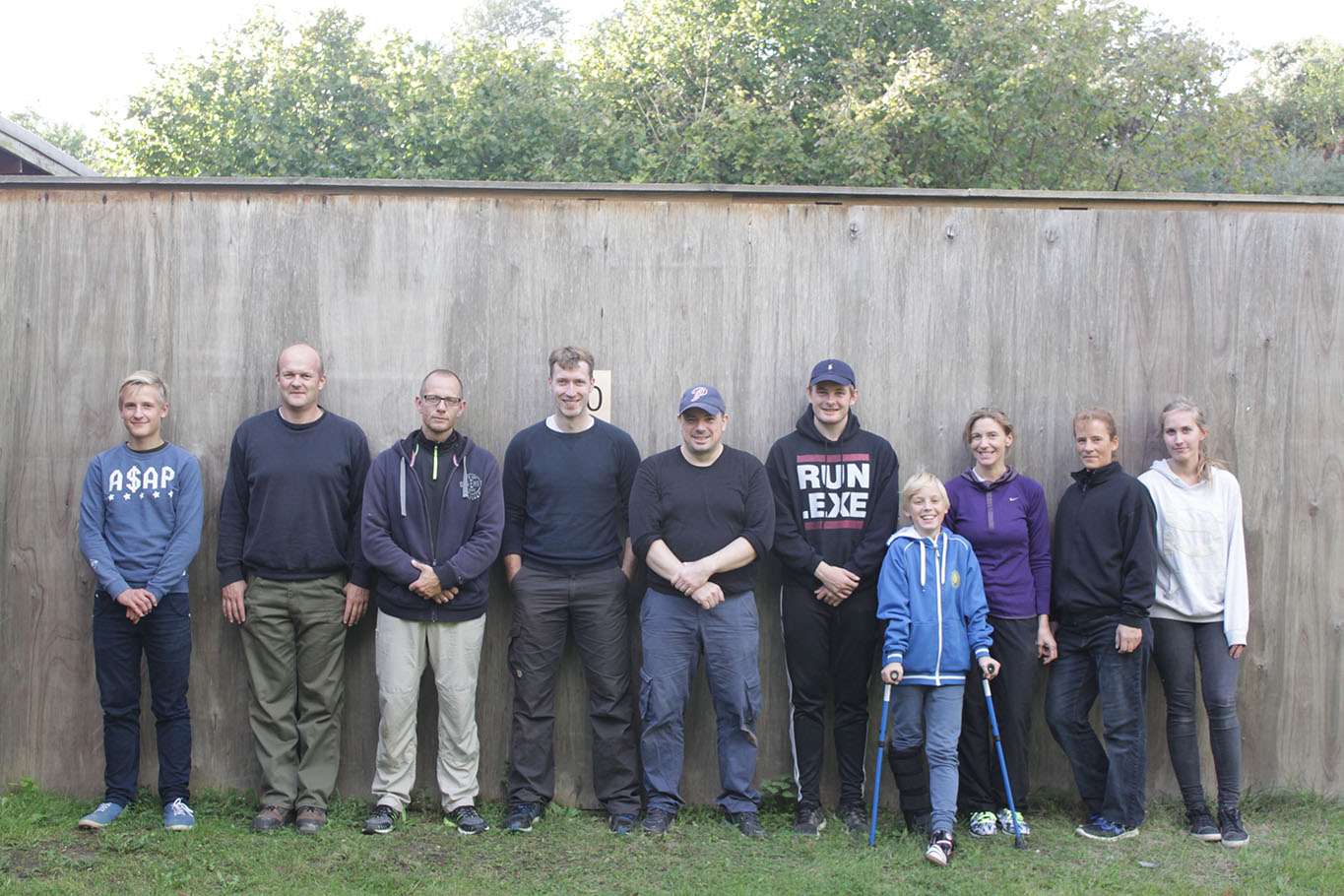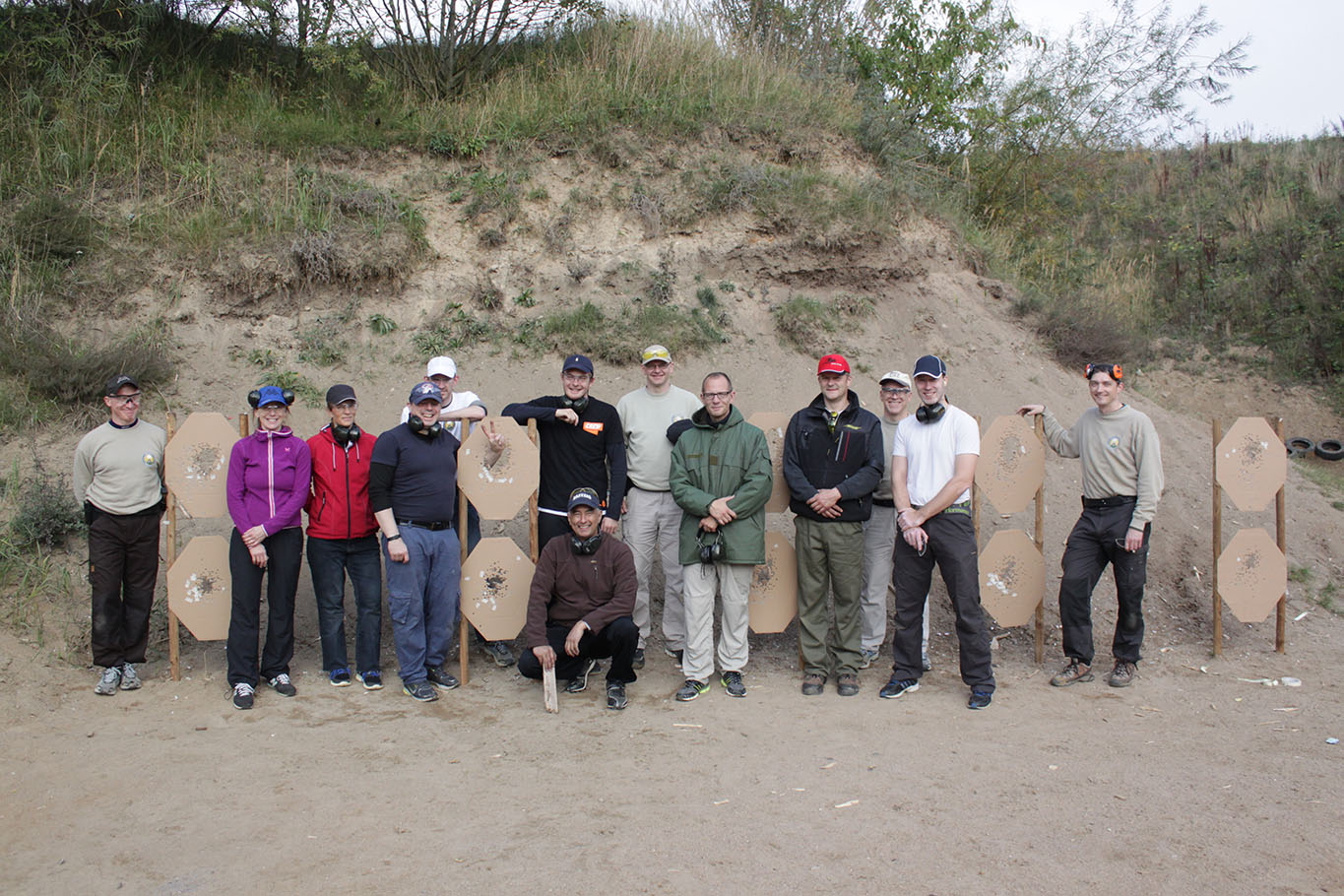
Best Consistent and Skilled Marksman on both POMW I to POMW III; Pia Hornung
Best life-affirming development from POMW I to POMW III: Thomas Elisberg and POMW chief instructor Kimu Sensei
You can read about the Shindenkan Honbu POMW project 2011-2013 at www.pomw.dk or www.pomwproject.com .
But in short; POMW – Project Old Modern Warrior. Where Shindenkan's general assembly decided to "put everything on the line". In 2010, Shindenkan Competence & Development Center's chief and sole resource, Yamana-Itotani Sensei, announced to the general assembly and the federation board that he had developed a very controversial idea to practically explain and demonstrate differences and similarities between the modern and ancient warrior. That the decisive factor is primarily the man behind the weapon, which is also timeless and independent of technical development, social norms and country of origin, and thus when there is a coincidence between comparable professional skills - between the old elite warrior and the new elite warrior.
The POMW project took its main point of departure within Martial Arts and Minouchi Sensei's theory of the man behind the weapon. His inner clarification and attitude is the most important factor for learning to shoot in the shortest possible time with the most optimal results, if these also receive the most optimal learning process and structure with the optimally correct shooting technical essence from the world's best legendary pistol, rifle and long-range marksman .
Since no one in Shindenkan had significant shooting experience, the starting point was ideal, but also extremely risky if the project were to fail. It didn't, but attracted international recognition and attention, as well as giving Shindenkan Competence and Development Center a completely unique network that very few in the world have.
The project led to the creation of SDKSkyt (www.sdkskyt.dk) , when POMW caused an outcry to say the least in the Danish shooting world, where we still experience "wave ripples" two years after the end of the project - but still persistent international interest and requests for cooperation.
The DGI IDAN report from 2012 states that approx. 83 % of all Danish shooters do not receive structured shooting instruction and that more than 50 % are not interested in this either. It is in direct opposition to the Shindenkan and POMW thinking. We are of the opinion that the schooled approach and "get everything served" through a structured POMW shooting technique training is the best way to learn a new skill. In addition, it can also be deduced from the report that the average Danish shooter shoots approx. 200-250 shots per year of approx. 6-10 annual training lessons. This is also in direct contrast to the POMW competence course over 3-3½ months with intensive free dry training and many shot series typically in the ratio 1:20 to 1:50. If the experience is calculated in number of shots, a typical POMW II course participant will have 2-3 years of Danish shooting experience and a POMW III course participant 6-7 years of Danish shooting experience cf. DGI IDAN report 2012. But on 3 and 3½ months where you "live the world of shooting".
The question then is whether POMW Shooter can achieve the same results as "normal Danish shooters" even after 3-3½ months as a minimum. It is not known with certainty, as this cannot be calculated, as no measurements exist for a normal Danish shooting course. The only thing that can be directly compared to is the Danish division's standard, and here the POMW results are at a completely unique and fantastic level of competence, which is noted internationally.
The Shindenkan Honbu POMW competence training consists of three training courses of a total of 3½ months relatively intensive competence course compared to normal shooting competence learning.
POMW I – June 26 to August 22, 2015 – approx. Two months;
- A. 4 hour lecture about the history, development and facts of shooting nationally and internationally, as well as the POMW project, as well as basic teaching in basic POMW dry training shooting technique.
- B. 8+ hours of instruction with airguns and SIRT Laserguns in the fundamental hand shooting disciplines through POMW shooting technique; Range shooting and safety.
- C. 8+ hours of instruction with airguns and SIRT Laserguns in the fundamental hand shooting disciplines through POMW shooting technique; Range shooting, transition shooting and IPSC – shooting formula 1, and increased safety.
- Approx. 2 months basic POMW dry training shooting technique 10-15 minutes ad hoc, preferably every day.
POMW I – August 22 to September 19, 2015 – approx. 1 month;
- A. 1 hour lecture and discussion forum about the history of shooting, development and facts nationally and internationally, as well as the POMW project, as well as earmarked teaching in basic POMW dry training shooting technique.
- B. 10+ hours of instruction with air pistol and .22 range shooting through POMW shooting technique, 15 m and 25 m; Range shooting, safety, basic gun understanding and functions through cleaning.
- C. 10+ hours of training with air pistol, 0.22 and coarse pistol 9 mm through POMW shooting technique, 15 m and 25 m; Range shooting, safety, basic gun understanding and functions through cleaning.
- Approx. 1 month basic POMW dry training shooting technique 15-20 minutes every day.
POMW III – September 19 to October 4, 2015 – approx. ½ month;
- A. 1 hour lecture and discussion forum about shooting disciplines, DGI-IDAN 2012 report, and facts nationally and internationally, as well as the POMW project, as well as targeted teaching in extended POMW dry training shooting technique.
- B. 10+ hours of instruction with 0.22 and 9 mm coarse pistol through POMW shooting technique, 7 m- 45 m; Open range – simple target shooting and transitions shooting against IPSC discs and metal plates in different sizes, safety, basic gun functions through cleaning.
- C. 10+ hours of instruction with 0.22 and coarse pistol 9 mm through POMW shooting technique, 7 m- 45 m; Open range – single target shooting and transitions shooting against IPSC discs and metal plates in different sizes, safety, basic gun functions through cleaning.
- Approx. ½ month basic POMW dry training shooting technique 20-30 minutes every day.
The third run of the POMW courses, 2015
It had now been two years since the last incredibly successful run of the Honbu POMW courses in 2013 (POMW goes ballistic) So it was time for another POMW run, where all participants can now also become members of the SDKSkyt shooting association by registering. Everyone chose it without exception. When the registration deadline expired, there was an oversubscription of 50 %, which unfortunately meant that we had to apologize to some of the participants, who have to wait until the next POMW competence course in 2017. But 14 approved Shindenkan members, 10 adults and 4 JokoKidz & teens started local savings approx. . 10 months before the course, so that the expenses could be equalized and the preparations, which are considerable, would not be in vain.
10 months also meant 10 months of preparation time for all SDKSkyt's shooting instructors, who had to go up to the POMW competence level again. When there is no POMW competence course, POMW shooting technique is maintained in SDKSkyt both indoors and outdoors. But every two years with the POMW competence course, the gear shifts up at a significantly higher speed. This can best be illustrated by the fact that 3-5 times as many good shots are typically shot for training as preparation, and the training frequency is increased from 1-3 hours of training to 5-7 hours of training lessons.
Depending on the content and the POMW marksmanship practice ranges, typically from 600 to 2,000 0.22 and 9 mm rounds are fired per round. gunnery instructor during a POMW training lesson. It is a very intensive course, which requires a very good and strong attitude, discipline and extremely good physical condition. Since all head instructors in Shindenkan meet DIF's definition of elite athletes and more, this is fulfilled. The new SHIELD KISS project, including "Moving meditation - Body, Mind, Soul United" KataFIT training has further contributed to this since the last run in 2013.
POMW IA was initiated by Jens Hanshi-dai shortly before the summer holidays with Kjeld Renshi-dai as POMW shooting technical instructor. Next, POMW IB and IC were handled by Søren Renshi and Martin Renshi and with Kjeld Renshi-dai as POMW shooting technical instructor.
As usual, everything was planned and coordinated by Honbu's Chief Instructor, Kimu Sensei, so nothing was left to chance and everything was of the international high and uniform standard that all Honbu's competency standards are.
The reason why Kjeld Renshi-dai was the POMW shooting technical instructor, belongs to the fact that he was the average most stable POMW instructor during SDKSkyt training in range shooting, which is not as intensive as during the POMW years. He never shot below the Danish 2nd division on his absolute worst days and the norm was the Danish 1st division. Only Kimu Sensei consistently shot above this in the high 280's and plus. I Can later read participant reports and a dedicated article with pictures about this process on the websites of Shindenkan and POMW.
For POMW II, it was now Kimu Sensei's task to teach range shooting at 15 m and 25 m. Søren Renshi acted as course manager with all the practical aspects and as assistant. Firing leader. All other chief instructors acted as firing commanders and were responsible for safety, security and safety. The results were slightly below par, but almost at the same level, despite POMW II being cut down to the original plan; from 3 to 2 teaching days. 11 out of the 14 participants passed POMW II Fundamentals with flying colours. I Can later read participant reports and a dedicated article with pictures about this process on the websites of Shindenkan and POMW.
For POMW III, it was again Kimu Sensei's job to teach. The difference from POMW II, where this took place on a specially designed range for, yes, range shooting at 15 m and 25 m. Then POMW III is out in the open and at distances from 7 m to approx. 45 m, where a 9 mm coarse gun is fired approx. 90 % and 10 % 0.22 standard pistol. This placed far greater demands on safety procedures, which all participants went through again and again. The shooting took place as single target shooting and transition shooting against IPSC discs and metal plates of different sizes with shot after shot within 1-5 seconds, depending on the distance.
Søren Renshi acted as course manager with all the practical aspects and as assistant. Shooting leader, Jens Hanshi-dai as back-up ass. fire leader. All other chief instructors acted as firing commanders and were responsible for safety, security and safety. The results were slightly below par, but almost at the same level, despite POMW III being cut down to the original plan; from 3 to 2 lessons. 7 out of the 14 participants passed POMW III Intermediate with flying colours.
Best consistent and best marksman on both POMW II and POMW III was a lady; Pia Hornung and best life-affirming development from POMW II to POMW III was a man: Thomas Elisberg.
I Can later read participant reports and a dedicated article with pictures about this process on the websites of Shindenkan and POMW.
The POMW project showed that, as with all other sports, it requires constant competence maintenance to maintain one's very best level. But the POMW project also shows that a recreation through shooting training of one's best level of competence is not linear, but an explosive upward parabola.
And when this is compared to the fact that every POMW shooter has gone through a standardized training course and thus has been given a competence-giving standardized toolbox, a POMW shooter will know exactly what this shooter needs to get up to level again.
POMW is a common professional competence in Shindenkan's toolbox. It is impossible to become a black belt or a master in Yakami Shinsei-ryu martial arts in just 3 months - well, you can't even achieve a beginner belt degree in this time. But! - as POMW shooting instructors in the POMW Pistol course with between 40-60 hours of POMW wet instruction and at least as much dry training at home, we are quite proud and very happy with the result and can already see that there are many in the future who will benefit profit from this process with; Focus on the person behind the weapon and not the other way around.
The POMW course will run again in 2017 and will again be available from 6.kyu, Yakami Shinsei-ryu. The POMW competence course is an integral part of the curriculum handbook and must be in house before 1.dan Sr. at the latest. Yakami Shinsei-ryu / 3rd dan karate-do, which is the last level in TG4 – Team Group 4.
Congratulations to all you POMW II and POMW III participants who passed with flying colors!







